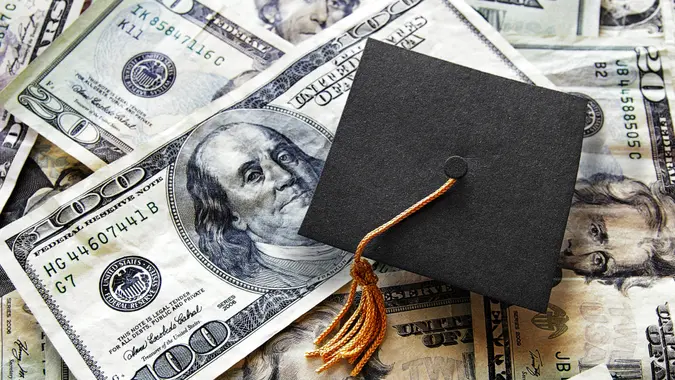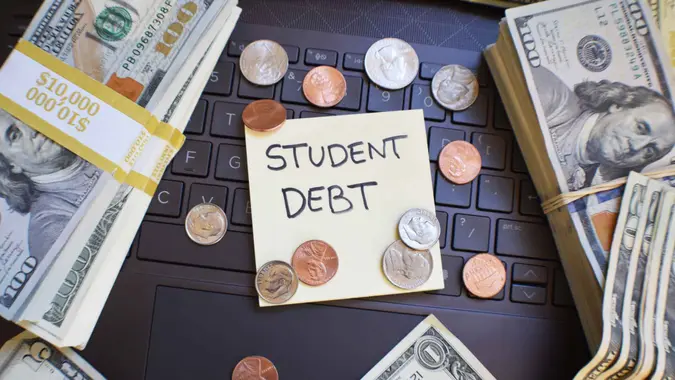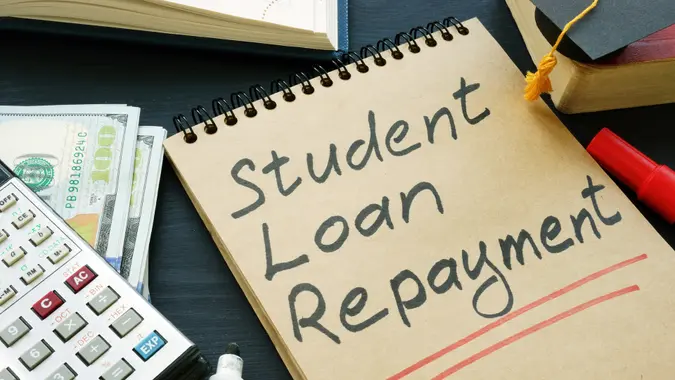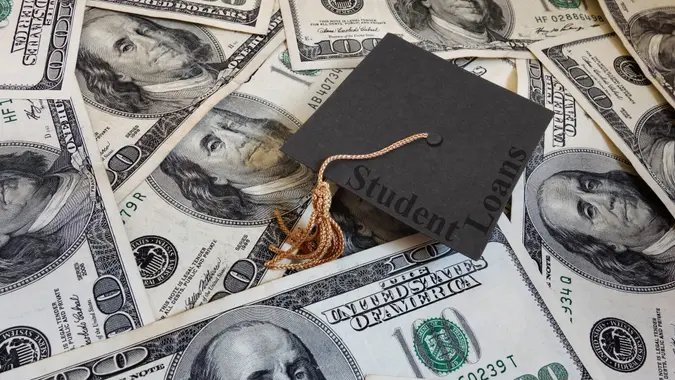6 Expenses To Cut To Pay Off Your Student Loans Faster, According to Experts

Commitment to Our Readers
GOBankingRates' editorial team is committed to bringing you unbiased reviews and information. We use data-driven methodologies to evaluate financial products and services - our reviews and ratings are not influenced by advertisers. You can read more about our editorial guidelines and our products and services review methodology.

20 Years
Helping You Live Richer

Reviewed
by Experts

Trusted by
Millions of Readers
According to the Education Data Initiative, the average American has $37,853 in federal student loan debt. For those who also have private student loans, the total average debt is over $40,000. In many cases, it can take around 20 years to pay off that much student loan debt.
Having student loans can be a major financial burden, one that makes it harder to achieve other goals — like saving up for a down payment on a house or investing in long-term financial security. If you have student loans, here are some expenses to cut to pay them off faster, according to experts.
Dining Out
Going out to eat every now and then is still okay, but if you do it frequently, try to cut back.
“Restaurant meals are generally more expensive than a home-cooked meal. Even cutting back slightly in this department can help!” said John Bunzel, head of deposit growth and engagement at TD Bank. “Treat takeout or a meal at a restaurant as a special occasion rather than a weekly occurrence and set aside the money saved to pay off other debts.”
Bunzel also suggested evaluating your essential expenses — like groceries, rent and prescriptions — and budgeting around those. Any areas where you can cut back is more money for your debts.
Coffee Runs
A basic cup of coffee at Starbucks can easily cost $2.50 to $3.00 — more if you upgrade sizes or ask for extras, like another shot of espresso. Some specialty drinks can run you over $5.
Instead of going out for coffee every day, cut back and brew your own drinks at home.
“If you spend $2.50 per cup daily, you may contribute more than $900 annually towards existing debt without sacrificing your favorite beverage,” Bunzel said.
Nonessentials
Your idea of “nonessential” items might be different from someone else’s, so take some time to define what you can — and cannot — live without. If you find yourself paying for something you don’t absolutely need, cut it out of your budget and put that money toward your loans.
Possible nonessentials include sports, gifts, entertainment and travel.
“Instead of planning large vacations, take 1-3 day mini-retreats a couple of times a year. The cost can be lowered by traveling within easy driving distance and focusing on free or low-cost activities,” said Hope Ware, owner at Under the Median.
Monthly Subscriptions and Memberships
According to Forbes, the average American consumer spends $46 on monthly streaming services. And that’s not including other monthly subscriptions, like those for mobile phones, internet, gaming, Amazon Prime and news services.
If you have any subscriptions you don’t often use, cancel them. Just be sure to check for any cancellation fees first.
“Consider cutting out any subscriptions and memberships, whether for the gym or entertainment, along with streaming services if you’re going over your budget,” Bunzel said. “While you don’t need to cut out everything, you may even have subscription services you forgot about! Some online apps can even tell you which subscriptions you use least frequently, so you can cut and budget accordingly.”
Name-Brand Goods
“Shop store brands over name brands,” Bunzel said. “Often times, the quality is comparable, but the price is much better. Even a few dollars saved can add up quickly.”
This applies to groceries, clothes and other daily essentials. You may even be able to switch to a generic version of certain medications — but consult your primary care provider first.
Tech or Other Upgrades
Do you spend a lot on tech or car upgrades? Unless your current device or vehicle is no longer working — or it’s a safety hazard — you might want to keep using it until you’ve paid down your student loans.
“I often see people replacing or upgrading items sooner than is necessary, increasing their monthly expenses, such as getting the newest cellphone when the one they have works fine, or getting a new or newer car when the one they have could last for at least a few more years,” said Nancy Butler, CFP, CDFA, CLTC, CSA, founder of Above All Else, Success in Life and Business. “By waiting to upgrade these items, you will have more money to apply to reduce your student loan debt. You can purchase these items once your debt is reduced.”
 Written by
Written by  Edited by
Edited by 























